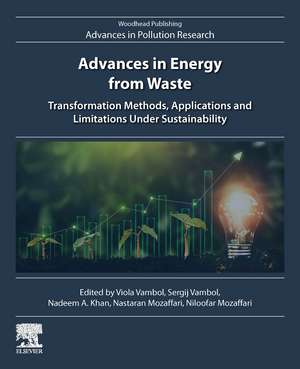Advances in Energy from Waste: Transformation Methods, Applications and Limitations Under Sustainability: Woodhead Advances in Pollution Research
Editat de Viola Vambol, Sergij Vambol, Nadeem A Khan, Nastaran Mozaffari, Niloofar Mozaffarien Limba Engleză Paperback – 22 iul 2024
- Serves as a starting point for further research into waste management and biomass conversion
- Provides an overview of recent developments in the field of waste-to-energy
- Discusses recent advances in biomass-derived green catalysts for various catalytic applications
- Introduces diverse case studies on waste, pollution, sustainability, technologies, health risk, and future prospective
Preț: 1463.37 lei
Preț vechi: 1909.13 lei
-23% Nou
Puncte Express: 2195
Preț estimativ în valută:
280.10€ • 304.36$ • 235.44£
280.10€ • 304.36$ • 235.44£
Carte tipărită la comandă
Livrare economică 14-28 aprilie
Preluare comenzi: 021 569.72.76
Specificații
ISBN-13: 9780443138478
ISBN-10: 0443138478
Pagini: 974
Dimensiuni: 191 x 235 mm
Greutate: 1.64 kg
Editura: ELSEVIER SCIENCE
Seria Woodhead Advances in Pollution Research
ISBN-10: 0443138478
Pagini: 974
Dimensiuni: 191 x 235 mm
Greutate: 1.64 kg
Editura: ELSEVIER SCIENCE
Seria Woodhead Advances in Pollution Research
Cuprins
Section-I (Waste Management Priorities)
1. Introduction
2. Characteristics of Typical Wastes of Various Genesis
3. Main Factors of Negative Impact of Waste Accumulation
4. Type of Industries, Waste Options and Their Potential5. Environmental Toxicities Due to the Accumulation, Processing and Destruction of Waste, Assessment Methods and Levels.
6. Health Risks Associated with the Accumulation and Processing of Waste
6.1 Pollution Load and its Assessment
6.2 Immediate Health Risk
Section-II (Waste to Energy and Resources Recovery)
7. Necessity to Recover Energy from Waste in Circular Bioeconomy
8. Possible Roadmap for the Circular Economy Using Waste-to-Energy Technologies
9. Waste to Energy Plant Around Globe: A Case Study Using Technoeconomic Analysis
10. Waste Recycling and Energy Production and its Future Scope.
11. Plastic/ Solid Waste Recycling for Energy Production: Case Studies.
12. Biowaste Biorefineries and Circular Bioeconomy
13. Critical Factors Affecting MSW Management Strategies and Waste to Energy Generation
14. Possible Roadmap for the Circular Economy Using Waste-to-Energy Technologies
15. Greenhouse Gases Emissions of the Studied WtE Routes and Importance in Circular Bioeconomy
15.1 Need and Basics of Utilizing GHG as Part of UN Sustainability Project
16. Biological Conversion into Bioethanol and Biodiesel of Municipal Biowaste and Future Prospective w.r.t to Circular Economy
Section-III (UN Sustainability Aspect of Waste to Energy)
17. Industry 4.0 Based Solid Waste Management and Future Prospect in Circular Economy
18. Plastic Waste Management Techniques and WtE Consideration in Developing Countries.
19. Sustainability Transitions of Urban Food-Energy-Water-Waste Infrastructure and WtE Prospective in Line City: Futuristic Case Studies.
20. Synergies and Interactions in Urban Waste to Energy Generation in Circular Economy
21. Legal Aspects and Problems of Legislation in the Field of Solid Waste Management in Some Developing Countries of Europe and Asia
Section-IV (Case Studies)
22. Case Studies on the Use of Waste in the Production of Agricultural Biogas in Poland.
23. Case Studies of Atmospheric Protection in Thermal Waste Treatment.
23.1 Pollution Load and Its Assessment
23.2 Protective Practices and Technologies that Reduce Health Risks
24. Case Studies of Obtaining Compost to Increase Yields
24.1 Features and Difficulties of Processes, and Its Evaluation of Effectiveness
24.2 Immediate Health Risk
24.3 Waste Management Aspect of Mining Waste and Its Resource Recovery
25. Case Studies of the Waste Potential of Some Developing Countries (Asia, Africa, Iran, and India).
26. Case Studies of the Legislative Framework for Realizing the Potential of Waste and Protecting the Environment in Relation to Their Generation and Use
27. Final Remarks and Perspectives for the Future.
1. Introduction
2. Characteristics of Typical Wastes of Various Genesis
3. Main Factors of Negative Impact of Waste Accumulation
4. Type of Industries, Waste Options and Their Potential5. Environmental Toxicities Due to the Accumulation, Processing and Destruction of Waste, Assessment Methods and Levels.
6. Health Risks Associated with the Accumulation and Processing of Waste
6.1 Pollution Load and its Assessment
6.2 Immediate Health Risk
Section-II (Waste to Energy and Resources Recovery)
7. Necessity to Recover Energy from Waste in Circular Bioeconomy
8. Possible Roadmap for the Circular Economy Using Waste-to-Energy Technologies
9. Waste to Energy Plant Around Globe: A Case Study Using Technoeconomic Analysis
10. Waste Recycling and Energy Production and its Future Scope.
11. Plastic/ Solid Waste Recycling for Energy Production: Case Studies.
12. Biowaste Biorefineries and Circular Bioeconomy
13. Critical Factors Affecting MSW Management Strategies and Waste to Energy Generation
14. Possible Roadmap for the Circular Economy Using Waste-to-Energy Technologies
15. Greenhouse Gases Emissions of the Studied WtE Routes and Importance in Circular Bioeconomy
15.1 Need and Basics of Utilizing GHG as Part of UN Sustainability Project
16. Biological Conversion into Bioethanol and Biodiesel of Municipal Biowaste and Future Prospective w.r.t to Circular Economy
Section-III (UN Sustainability Aspect of Waste to Energy)
17. Industry 4.0 Based Solid Waste Management and Future Prospect in Circular Economy
18. Plastic Waste Management Techniques and WtE Consideration in Developing Countries.
19. Sustainability Transitions of Urban Food-Energy-Water-Waste Infrastructure and WtE Prospective in Line City: Futuristic Case Studies.
20. Synergies and Interactions in Urban Waste to Energy Generation in Circular Economy
21. Legal Aspects and Problems of Legislation in the Field of Solid Waste Management in Some Developing Countries of Europe and Asia
Section-IV (Case Studies)
22. Case Studies on the Use of Waste in the Production of Agricultural Biogas in Poland.
23. Case Studies of Atmospheric Protection in Thermal Waste Treatment.
23.1 Pollution Load and Its Assessment
23.2 Protective Practices and Technologies that Reduce Health Risks
24. Case Studies of Obtaining Compost to Increase Yields
24.1 Features and Difficulties of Processes, and Its Evaluation of Effectiveness
24.2 Immediate Health Risk
24.3 Waste Management Aspect of Mining Waste and Its Resource Recovery
25. Case Studies of the Waste Potential of Some Developing Countries (Asia, Africa, Iran, and India).
26. Case Studies of the Legislative Framework for Realizing the Potential of Waste and Protecting the Environment in Relation to Their Generation and Use
27. Final Remarks and Perspectives for the Future.






